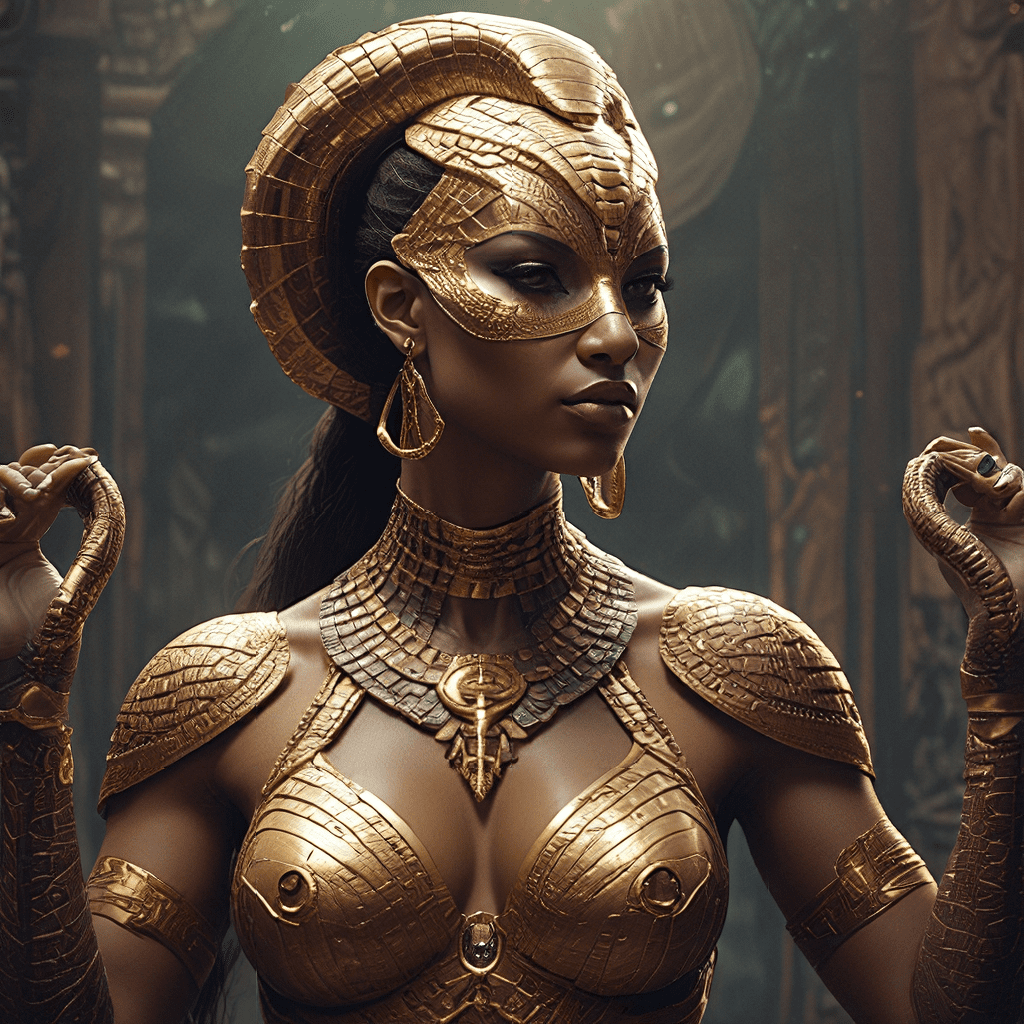The Uraeus: The Power and Protection of the Cobra Goddess
In the ancient world, symbols held deep meaning and power. One such symbol, etched into the hearts and minds of the Egyptians, was the Uraeus. More than a simple image, the Uraeus was a powerful representation of protection, divine authority, and the fierce feminine energy that resonated throughout Egyptian civilization. This cobra goddess, known as Wadjet, was an integral part of Egyptian myth, art, and everyday life.
1. The Uraeus: A Symbol of Power and Protection
The Uraeus, often depicted as a rearing cobra with a flared hood, was a symbol of immense power and protection. Its presence was a constant reminder of the divine forces that watched over the land and its people. This protective power was believed to ward off evil, disease, and any threat to the well-being of the pharaoh and the nation. The Uraeus was a formidable force, embodying the ferocity of the serpent and the divine energy of the goddess Wadjet.
2. The Uraeus in Ancient Egyptian Mythology: The Cobra Goddess Wadjet
At the heart of the Uraeus symbol lies the cobra goddess Wadjet. In Egyptian mythology, Wadjet was the protector deity of Lower Egypt, the fertile land in the Nile Delta. Her fierce gaze and powerful venom were believed to defend against all threats, making her a symbol of both strength and vigilance. Wadjet was often depicted as a cobra, her image associated with the sun and its life-giving power. This connection to the sun further solidified her role as a protective force, warding off darkness and evil.
3. The Uraeus as a Symbol of Royal Authority and Divine Right
The Uraeus was not only a symbol of protection but also a powerful representation of royal authority and divine right. Egyptian pharaohs, considered to be living gods, were seen as embodiments of divine power. The Uraeus, often depicted on their crowns, signified their connection to the divine and their right to rule. The cobra goddess Wadjet, by association, became a symbolic guardian of the pharaoh, a powerful force behind their reign and a testament to their divine lineage.
4. The Uraeus’s Protective Role: Banishing Evil and Warding Off Dangers
The Uraeus was believed to actively protect against evil and danger. Its fierce gaze, often depicted with a menacing expression, was believed to ward off evil spirits, envious deities, and any threat that might harm the pharaoh or the land. As a talisman, the Uraeus was carved into amulets and worn as adornments, offering its protective power to the wearer. The cobra’s venom, associated with death and destruction, was transformed into a potent force of protection, symbolizing the ability to neutralize and defeat any threat.
5. The Uraeus in Egyptian Art and Architecture: A Constant Presence
The Uraeus was a pervasive symbol, appearing throughout Egyptian art and architecture. From the towering monuments to the intricate details of everyday objects, the cobra goddess was a constant presence, reminding the people of their connection to the divine and the power of protection. The Uraeus adorned the crowns of pharaohs, the walls of temples, and the sarcophagi of the dead, ensuring its influence permeated every aspect of Egyptian life. The Uraeus was more than a decorative element; it was a symbol of faith, hope, and the enduring power of the divine.
6. The Uraeus’s Connection to the Sun God Ra: The Serpent of the Sun
The Uraeus’s connection to the sun god Ra further reinforces its association with power and protection. In Egyptian mythology, Ra, the sun god, was the creator and sustainer of all life. The Uraeus, as a symbol of the sun’s energy, was believed to carry the warmth and power of Ra, repelling darkness and evil. This connection to the sun solidified the Uraeus’s role as a guardian of light and a protector against the forces of chaos and darkness.
7. The Uraeus Across Different Periods of Egyptian History: A Symbol of Continuity
The Uraeus remained a powerful symbol throughout the different periods of Egyptian history. From the Old Kingdom to the Ptolemaic era, its presence was unwavering, demonstrating its enduring relevance and timeless appeal. This consistency across centuries reflects the deep cultural significance of the Uraeus and its role as a symbol of continuity and stability.
8. The Uraeus in Modern Culture: A Symbol of Egypt and its Heritage
Today, the Uraeus continues to be a powerful symbol of Egypt and its rich heritage. It is frequently used in modern art, design, and jewelry, reminding people of the enduring power of this ancient symbol. The Uraeus remains a visual representation of the ancient Egyptian civilization, its fierce power and protective energy resonating with people across time and cultures.
9. The Uraeus in Popular Culture: Examples of its Influence
The Uraeus has found its way into modern popular culture, appearing in film, literature, and video games. Its striking imagery and powerful symbolism have made it a popular motif for Egyptian-themed works, reflecting its enduring influence as a cultural icon. The Uraeus reminds us of the enduring power of ancient symbols and their ability to resonate with modern audiences.
10. The Enduring Legacy of the Uraeus: A Symbol of Power, Protection, and the Divine Feminine
The Uraeus, a symbol of power, protection, and the divine feminine, has left an enduring legacy on the world. Its powerful imagery continues to inspire and intrigue, reflecting the enduring power of ancient symbols and their ability to transcend time and culture. The Uraeus remains a testament to the strength and resilience of the ancient Egyptians, their belief in divine protection, and the enduring legacy of the cobra goddess Wadjet.





